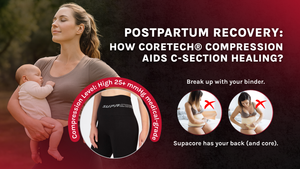Postpartum Recovery: How Coretech® Compression Aids C-Section Healing
Recovering from a C-section is no small feat. It’s major surgery, and your body needs time, support, and the right tools to heal properly — all while adjusting to life with a newborn. Supacore’s Coretech® postpartum compression garments are designed to help women recover faster and more comfortably after cesarean birth, with clinically informed support that focuses on core stability, scar protection, and overall mobility.
Here’s how it works.
Understanding the C-Section Recovery Journey
A cesarean section involves multiple layers of tissue — including skin, muscle, and uterus — being surgically opened and then repaired. Recovery includes healing these layers while managing inflammation, pain, and the added strain of caring for a baby. Common post-op challenges include:
- Abdominal tenderness and swelling.
- Core weakness and instability.
- Difficulty moving, standing, or lifting.
- Risk of scar adhesion or poor tissue healing.
Without proper support, these challenges can lead to longer recovery times and potential complications (Cunningham et al., 2022; Lavergne et al., 2020).
Where Coretech® Compression Comes In
Supacore’s patented Coretech® technology is clinically designed to replicate the body’s natural deep core stabilizers. This targeted, medical-grade compression provides essential post-surgical support — especially around the abdominals, lower back, and pelvis.
Here’s what that means for C-section recovery:
1. Stabilizes the Core Without Restricting Movement
After surgery, your core can feel weak, unsupported, and vulnerable. Coretech® garments gently reinforce this area, offering external support so your muscles don’t have to work as hard. This reduces tension on the healing scar and helps you move with more confidence and less pain — from getting out of bed to carrying your baby (Chiarello et al., 2005).
2. Reduces Pain and Swelling
Compression is widely used in post-surgical care for its ability to minimize inflammation, enhance venous return, and reduce pain (Zisselman & Berg, 2004). Coretech® garments apply consistent, medical-grade pressure that:
-
Decreases swelling around the incision.
-
Eases pressure on tender abdominal muscles.
-
Promotes healing by improving circulation to the area.
3. Protects the Incision Site
Scar tissue around the incision can form unevenly, potentially causing discomfort or adhesions. By supporting the surrounding area with controlled compression, Coretech® helps maintain tissue alignment, which promotes healthier scar formation while reducing tension on the incision (Rathore et al., 2018).
4. Improves Posture and Reduces Strain
Caring for a newborn means constant movement — feeding, rocking, lifting — which can strain your healing body. Coretech® compression improves postural awareness and reduces pressure on your lower back and pelvic floor, lowering the risk of compensatory injuries and chronic pain (O'Sullivan & Beales, 2007).
5. Supports Pelvic Floor & Full-Body Recovery
Even with a C-section, your pelvic floor undergoes significant stress during pregnancy. Compression garments like Supacore's help engage your deep core and pelvic stabilizers, encouraging muscle reactivation and alignment. This is essential for reducing pelvic instability, lower back pain, and other postpartum discomforts (Thompson et al., 2007).
More Than Just Support — Confidence, Comfort, and Care
Supacore postpartum shorts and leggings are designed for the real-life needs of new mums:
- Seamless and breathable for all-day wear.
- Flexible stretch zones that move with your body.
- Anti-chafing fabric for added comfort.
- Durable and machine washable (tested up to 150 washes).
- Eligible for health fund rebates in Australia.
Plus, they’re sustainably manufactured, minimizing environmental impact while maximizing support.
Heal Smarter, Not Harder
Your postpartum journey is personal — and your recovery should be supported with care and science. Supacore’s Coretech® compression is more than a garment; it’s a clinical-grade tool designed to help you recover stronger, faster, and more comfortably after C-section.
Because healing your core isn’t just about getting back — it’s about moving forward with strength.
References (APA Style)
Chiarello, C. M., Falzone, L. A., McCaslin, K. E., Patel, M. N., & Ulery, K. R. (2005). The effects of an abdominal support on functional activities in postpartum women. Journal of Women's Health Physical Therapy, 29(1), 11–18. https://doi.org/10.1097/00152166-200501000-00003
Cunningham, F. G., Leveno, K. J., Bloom, S. L., Spong, C. Y., Dashe, J. S., Hoffman, B. L., ... & Sheffield, J. S. (2022). Williams Obstetrics (26th ed.). McGraw-Hill Education.
Lavergne, S., Doucet, S., & van Schaik, S. (2020). Recovery experiences of women following a cesarean section: A qualitative study. Journal of Obstetric, Gynecologic & Neonatal Nursing, 49(4), 364–374. https://doi.org/10.1016/j.jogn.2020.03.007
O’Sullivan, P. B., & Beales, D. J. (2007). Diagnosis and classification of pelvic girdle pain disorders—Part 1: A mechanism based approach within a biopsychosocial framework. Manual Therapy, 12(2), 86–97. https://doi.org/10.1016/j.math.2006.11.005
Rathore, M., Sharma, A., & Singh, R. (2018). A comparative study on the effectiveness of kinesiotaping and abdominal binder in post cesarean patients. International Journal of Physiotherapy and Research, 6(3), 2753–2759. https://doi.org/10.16965/ijpr.2018.127
Thompson, J. A., O'Sullivan, P. B., & Briffa, N. K. (2007). Recovery of pelvic floor and abdominal muscle function in postpartum women: Prospective study using transabdominal ultrasound and perineometry. Neurourology and Urodynamics, 25(5), 375–382. https://doi.org/10.1002/nau.20211
Zisselman, M. H., & Berg, J. E. (2004). Use of compression to treat postoperative swelling. Plastic and Reconstructive Surgery, 114(4), 1048–1053. https://doi.org/10.1097/01.prs.0000132350.27581.15

